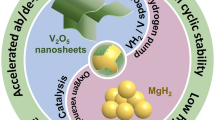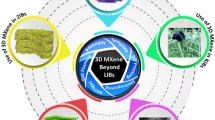Abstract
Hydrogen storage in advanced solid state materials has been an intense area of research due to many drawbacks in conventional high pressure or cryogenic liquid hydrogen storage methods. A practical hydrogen storing material is required to have high storage capacity and fast dehydrogenation kinetics. Among many solid state materials for hydrogen storage, magnesium hydride (MgH2) combines a hydrogen capacity of 7.6 wt % with the benefit of the low cost of production and abundance. The main difficulties for implementing MgH2 are slow absorption/desorption kinetics and high reactivity towards air and oxygen, which are also common issues in most lightweight metal hydrides. Previously, improvements in hydrogen storage and release properties have been reported by using nanostructured magnesium that can be obtained through various fabrication methods including ball-milling, mechanical alloying, and vapor transport. In this study, we investigate the hydrogen absorption and desorption properties of magnesium “nanotrees” fabricated by glancing angle deposition (GLAD) technique, and also conventional Mg thin films deposited at normal incidence. Mg nanotrees are about 15 μm long, 10 μm wide, and incorporate “nanoleaves” of about 20 nm in thickness and 1,2 μm in lateral width. A quartz crystal microbalance (QCM) gas absorption/desorption measurement system has been used for our hydrogen storage studies. Nanostructured and thin film Mg have been deposited directly on the surface of the gold coated unpolished quartz crystal samples. QCM hydrogen storage experiments have been performed at temperatures ranging between 100-300 °C, and at H2 pressures of 10 and 30 bars. Our QCM measurements revealed that Mg nanotrees can absorb hydrogen at lower temperatures and also at a faster rate compared to Mg thin film. In addition, Mg nanotrees can reach hydrogen storage values of about 4.80 wt% at 100 °C, and up to about 6.71 wt% (which is close to the theoretical maximum storage value of Mg) at temperatures lower than 150 °C. The significant enhancement in hydrogen absorption properties of our Mg nanotrees is believed to originate from novel physical properties of their nanoleaves. These nanoleaves are very thin (∼20 nm) and both surfaces are exposed to hydrogen enhancing the diffusion rate of hydrogen together with a decreased diffusion length. Based on X-ray diffraction measurements, individual nanoleaves have non-close-packed crystal planes that can further enhance the hydrogen absorption kinetics. In addition, our nanostructured Mg have been observed to quite resistant to surface oxidation, which is believed to due to the single crystal property of the Mg nanoleaves, which further improves the absorption kinetics of hydrogen.
Similar content being viewed by others
References
A. Zaluska L. Zaluski and J. O. Strom-Olsen, J. of Alloys and Compounds 288 217 (1999).
P. K. Pranzas M. Dornheim D. Bellmann K.F. Aguey-Zinsou, T. Klassen A. Schreyer Physica B385 630 (2006).
A. Zaluska L. Zaluski and J. O. Strom-Olsen, J. of Alloys and Compounds 289 197 (1999).
J. Huot, G. Liang S. Boily A. Van Neste and R. Schulz J. of Alloys and Compounds 293-295 495 (1999).
M. Au Mat. Scie. and Eng. B117, Issue 1 37 (2005).
T. Karabacak G.C. Wang and T.M. Lu J. Vac. Sci. Technol. A22 1778 (2004).
F. Tang T. Karabacak P. Morrow C. Gaire G.C. Wang and T.M. Lu Phys. Rev. B72 165402 (2005).
T. Karabacak A. Mallikarjunan J.P. Singh D.X. Ye G.C. Wang and T.M. Lu “β-phase W nanorod formation by oblique-angle sputter deposition,” Appl. Phys. Lett. 83 3096 (2003).
F. Tang T. Parker H.F. Li G.C. Wang T.M. Lu J. Nanosci. Nanotechnol. 7 (2007) 3239.
Y.P. He Y.P. Zhao J.S. Wu, Appl. Phys. Lett. 92 (2008) 063107.
Martin Ihor Kulchytskyy G. Kocanda and Tao Xu, Appl. Phys. Lett. 91 113507 (2007)
6 X. S. Li H. W. Xu C. L. Xu Z. Q. Mao and D. H. Wu Int. J. Hydrogen Energy 28, 1251 (2003).
E. Henneberg B. Bernhardt and K. Bohmhammel Thermochim. Acta 415 43 (2004).
D. A. Buttry and M. D. Ward Chem. Rev. _Washington, D.C._ 92 1355 (1992).
J. Aarik A. Aidla and K. Kukli Appl. Surf. Sci. 75 180 (1994),
J. W. Elam and M. J. Pellin Anal. Chem. 77 3531 (2005).
Author information
Authors and Affiliations
Rights and permissions
About this article
Cite this article
Mehmet, F.C., Karabacak, T. Enhanced Hydrogen Storage Properties of Magnesium Nanotrees with Nanoleaves. MRS Online Proceedings Library 1216, 503 (2009). https://doi.org/10.1557/PROC-1216-W05-03
Received:
Accepted:
Published:
DOI: https://doi.org/10.1557/PROC-1216-W05-03




